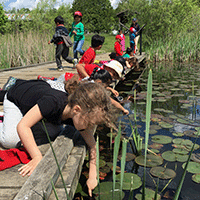Topic Exploration
For my inquiry project, I want to choose Outdoor Education as my topic.
Bai (2005) stated that there two kinds of learning in the world, one is for tangible and predictable outcomes such as school learning, another one is for uncertain and unpredictable outcomes just like inquiry. Knowledge on textbooks is concluded by experienced experts, they did as many tests as they could to show a summary for their learners, this kind of knowledge is useful, authoritative, but boring. However, inquiry is quest for meaning or value and so on which starts with the suspicion and realization to help students realize their power. Students raise questions and then look for answers with the help of teachers, that is inquiry. But the most important element of inquiry is the process of inquiry, students can develop their passion and curiosity of unknown things, looking for the connection of different things and the ability of solving problems. Outdoor education is a part of inquiry activities.

Many educators and researcher have done some researches and activities about outdoor education, Farmer et al., (2007) stated that outdoor education activities; are known as activities that take children outside the classroom and help them to learn knowledge in a natural environment. These outdoor educational activities are experimental, open air learning methods based on interdisciplinary curriculum which require the use of all senses involving humans and natural resources. It is an effective method which enables students to learn a subject more permanently and to bear more positive feelings towards both nature and to their friends (as cited in Tas& Gulen, 2019).
As I learned, the history of outdoor education in Canada can be dated from 19th century. Bone (2010) investigated that Canada is the second largest country in the world, and nearly 40% of Canada consists of forests and 9% consists of freshwater lakes and rivers. Because of the geographical and cultural scope of Canada, it means outdoor education may take a variety of forms and cover a range of topics. The first documented outdoor education program in Canada was Big Cove “Young Men’s Christian Association” (YMCA) Camp in 1889 (Purc-Stephenson et al., 2019). Raffan (1996) investigated that the education system introduced outdoor education programs later, with the most growth occurring between 1950 and 1980 (as cited in Purc-Stephenson et al., 2019). On contrary, outdoor education is a new term for most of the Chinese educators, the development of outdoor education activities is really low. Because of the traditional Chinese educational system and the geographical condition, we hardly ever see outdoor education activities in Chinese school. In urban area, students have better educational resources than those in rural area, however, they do not have outdoor education places. It is a big problem for Chinese students to take outdoor education.

As the development of economy and the change of educators’ thoughts, outdoor education comes into people’s eyes. The Ministry of Education has published many new standards for science and outdoor education. In 2017, The Ministry of Education in China published the Elementary School Science Curriculum Standard. In this new curriculum, the aims of the course are: 1. through the primary school science course learning to help students learn the basic scientific knowledge related to the common things around, and applied them to daily life, gradually developing scientific behaviour and living habits; 2.Understand the process and methods of scientific inquiry, try to apply them to scientific inquiry activities; 3. Maintain and develop the curiosity and thirst for knowledge of the surrounding things, and love science; 4. Get close to the nature, appreciate the nature, cherish our life, actively participate in the protection of resources and environment, and care about the new development of science and technology (Elementary School Science Curriculum Standard, 2017).
There are four fields in this course, I think this most related one is Life Science, in this field, teachers will help students to stimulate their interest in learning and understanding the natural world, form the overall views of natural diversity, and help students to develop thoughts of love creatures on the earth and the nature (Elementary School Science Curriculum Standard, 2017).
When I do the topic exploration, I found a new world for me in education. In the past, most of my education experiences were in the classroom, I hardly went to outside the classroom to learn about the world. In my exploration, I found there are two representative schools in Australia and Canada, which use outdoor education as their main teaching strategies, are Bush Kindergarten and Forest and Nature School. Both schools respond to a child’s right and need to access natural spaces for optimum learning and development. This kind of education is totally different from traditional Chinese education system.
The key question of outdoor education: 1. The differences of between indoor education and outdoor education. 2. The difficulties for the apply of outdoor education in China. 3. What will children learn from outdoor education?
References
Purc-Stephenson, R. J., Rawleigh, M., Kemp, H., & Asfeldt, M. (2019). We Are Wilderness Explorers: A Review of Outdoor Education in Canada. Journal of Experiential Education, 42(4), 364–381. https://doi-org.ezproxy.tru.ca/10.1177/1053825919865574
Tas, E., & Gulen, S. (2019). Analysis of the Influence of Outdoor Education Activities on Seventh Grade Students. Participatory Educational Research, 6(2), 122–143.
TEDx Talks. (2014, July 3). Why environmental and outdoor education matter | Maggie Gaddis | TEDxYouth@CrestAcademy [Video]. https://youtu.be/yYG6yk4u-tQ
The Ministry of Education. (2017). Elementary School Science Curriculum Standard. http://www.moe.gov.cn/srcsite/A26/s8001/201702/W020170215542129302110.pdf
https://images.app.goo.gl/sAB3Jhz7TJLrNCA39
https://images.app.goo.gl/h2FBedKsx5s29Tkb7